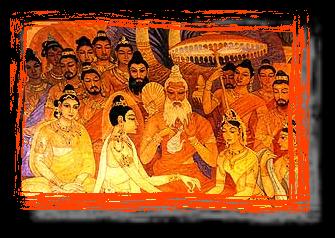
|
Bellanwila
Bellanwila Raja Maha Viharaya
houses a series of
painted murals depicting
several episodes in the life
of the Gautama Buddha. The
largest of the murals - a
full 6 metres by 14 metres,
is a single unified
composition depicting 13
episodes in the life of the
prince, from early childhood
up to the time of his enlightenment. These include Siddhartha's education
in music and the arts; his
training as a young warrior
in the martial arts, archery
and swordsmanship, his
marriage ceremony, his indulgence
in sensual
pleasures, his experiences
traveling outside the
place grounds (where the
young prince witnessed the suffering that encountered him to seek a way
to end
all suffering), his association
with hermits, ascetics and philosophers, and finally, his achievement of
nirvana.
|
|
Wood Carvin
Wood panel from an old door
... Lion has always been revered in Sri Lankan lore. After all, the major
race in Sri Lanka, the Sinhalese
, are supposed to be descendants
of a lion. (Sinha,
lion and le', blood in Sinhala,
the
language of the majority
of the people). The lion is also prominently displayed on the flag of Sri
Lanka.This wood carving of a lion, possibly part of a set, looks well aged
from the appearance, and
the fine patina that it has acquired.Most likely places to see native hardwood
(teak, mahogany, ebony)
panels like these are the
old Buddhist temples, and
some of the old mansions
that belong to some of the
established
families in the country.
|
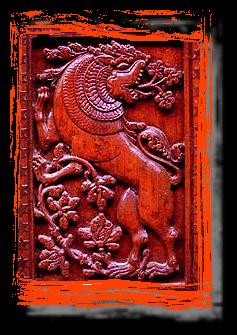
|
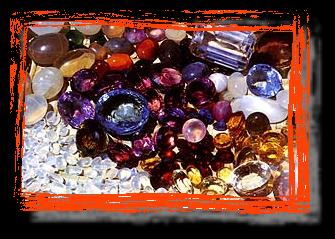
|
Gems
From time immemorial Sri
Lanka has had a
sparkling reputation for
highly treasured gems.
Nature in her bounty has
chosen the bosom of
Sri Lanka to enshrine some
of her rarest treasures.
Blue Sapphires, Cat's Eyes,
Alexandrites, Rubies,
Star stones found embedded
in layer of gravel and
sand, in river beds, marshes,
fields or accumulated
at the foot of hills have
made Sri Lanka the renowned
island for gems. These precious
stones perfected
in the laboratory of nature
lay hidden of countless
ages,their luster undimmed,
their value unrecognized.
To read more about Sri
Lanka Gems
please follow this link.
|
|
A Faberge' elephant?
A Faberge' elephant?. No,
not quite. Exquisite enough
to be one though. This gem
and jewelry adorned ivory carving is a part of a collection of gems and
jewelry at
one of the biggest gem merchants
in Sri Lanka. Carving
Ivory into intricate and
exquisite objects has a long
history in south-east Asia,
where ivory was abundant
at one time before the invading
forces from the West discovered the mysterious East. The kings and queens
in that part of the world
always encouraged art, and
artisans, jewelry makers,
and painters among other
various craftsmen were part
of the Royal Entourage.
They were provided with
a livelihood free of day-to-day worries, so that they can spend their full
time and effort
to do what they were good
at. This may have been
the start of the
Caste
system that was prevalent in
countries like India and
Sri Lanka until mass
communication and mass transport
made
intermixing between the
various castes possible,
and thus the end of the
system.
This carving appears to
be that of Raja, the
head elephant of Dalada
Maligawa, the Temple of the
Tooth in Kandy,
carrying the sacred tooth relic
on its back during the Esala
Perahara. )
|
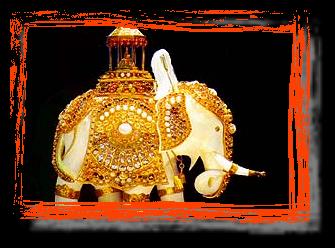
|
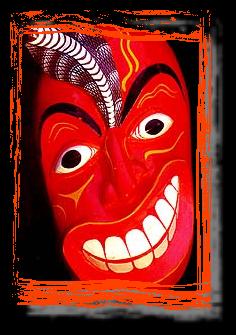
|
Masks
A vast majority of the people
of Sri Lanka are
Buddhists. But throughout
history, folk cults with
beings of supernatural powers
that influence
day-to-day lives of the
people have entered the
main stream Buddhism. There
are elaborate rituals
to pacify the evil spirits,
and to appease the
benevolent. Although not
encouraged by the
Buddhist clergy, there is
a large following of these
rituals, specially in the
southern part of the country.
One of the most often performed
rituals is the
devil dancing, which
is a form of exorcism, with
quitea bit of spirited dancing,
beating of drums,
and chanting thrown in for
good measure. The
colorful and sometimes frightening
masks worn
by the performers, represent
the good and evil
spirits.These masks are
all hand crafted by
traditional craftsmen out
of local soft woods and
can be quite elaborate.
The town of Ambalangoda in southern Sri Lanka is famous for these masks.
|
|
Mirror wal
o adorn the "mirror wall"
of the rock fortress
Sigiriya
in the northern plains of Sri Lanka. Painted in brilliant colors on mirror-finished
plaster wall, some
believe that they are asparas,
heavenly nymphs.
Perhaps they were ladies
of the court on their way
to the temple or even ancient
"pinups" for the
entertainment of the lonesome
young ruler. Painted
during the reign of King
Kasyapa in the fifth century
(A.D.), these frescoes have
retained their brilliant
colors until this day, protected
from the sun, wind,
and rain by the overhanging
rock. Accompanying
these frescoes are graffiti
left by the ancient visitors,
that are considered to be
some 1,000 or more,
years old. Although these
speak of "five hundred
damsels", today there are
only eighteen to be seen.
Note: Some 30 years ago,
in 1967, vandals
succeeded in obliterating
several of these
priceless frescoes, but
with the help of the
Smithsonian Institution
in Washington D.C.
they were restored to their
former splendor.
|
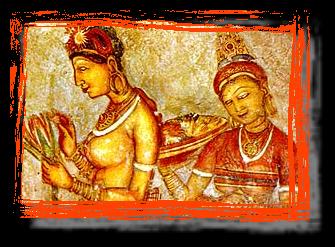
|
|
